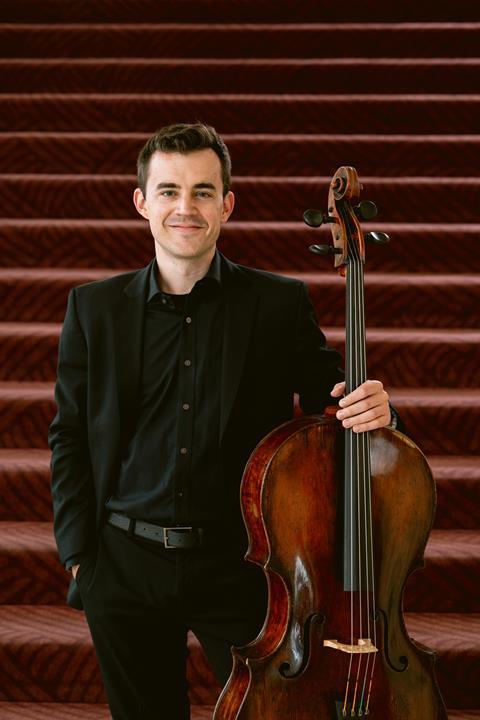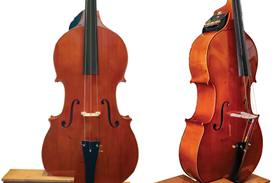US correspondent Thomas May speaks with Rainer Eudeikis, San Francisco Symphony’s principal cellist, about the unusual challenges of performing the Cello Concerto by the orchestra’s music director.

Discover more Featured Stories like this in The Strad Playing Hub
Now in his third full season as the San Francisco Symphony’s principal cello, Rainer Eudeikis makes his solo debut with the orchestra on 18-20 October in a work by the orchestra’s music director, Esa-Pekka Salonen: the Cello Concerto written by the Finnish composer-conductor for Yo-Yo Ma, who gave the world premiere in 2017.
It was Salonen who appointed Eudeikis principal cellist, thus filling a key position that had been left vacant since the death in 2019 of longtime SFS member Michael Grebanier. Eudeikis, 34, had been serving as principal with the Atlanta Symphony before moving with his family to the Bay Area to begin his tenure in February 2022. His primary mentor at Indiana University was Eric Kim, and he additionally studied with Carter Brey and Richard Aaron.
Salonen’s stature as a conductor has been reinforced by the reporting around his announcement, earlier this year, that he will resign from his SFS post at the end of the current season (when his contract expires). But the Cello Concerto, a work of remarkable scope, vision and invention that is one of Salonen’s longest scores, offers powerful evidence of his significance as a composer.
Cosmic images of “consciousness developing from clouds of dust” in Salonen’s own commentary on the piece bring to a mind a 21st-century maximalist with an ambitiously imaginative take on the traditional concerto – perhaps even echoing what Mahler did for the symphony.
’I imagined the solo cello line as a trajectory of a moving object in space being followed and emulated by other lines/instruments/moving objects – a bit like a comet’s tail,’ Salonen remarks with reference to the first movement, which he initially titled ‘Chaos to line’ in his sketchbook.
Just a few days before the concerts, when he will perform Salonen’s Cello Concerto for the first time, Eudeikis spoke about makes the challenging work so appealing.
You had previously been principal cello in Atlanta and, before that, with the Utah Symphony, as well as for the Mainly Mozart Festival and Cabrillo Festival. What has it been like adjusting to the San Francisco Symphony?
I felt very free to come in and do the job and play in the way that I know. I wasn’t held to some pre-existing notion of what it means to do my job in a specific way. From the beginning, I felt very supported in leading the section and playing with the orchestra. I’m fortunate to have had enough experience that I didn’t arrive with a big question mark, wondering: ‘How do I do this?’ Esa-Pekka and I are fortunately very much on the same page. We got used to each other pretty quickly.
What, in your view, makes Salonen’s Cello Concerto so interesting?
I don’t really identify as a ‘new music’ person in general. Especially as a soloist, I usually stick to the standard repertoire. This piece certainly does feel new, and the language is contemporary. It takes a second for me to wrap my fingers and also my ear around some things. But there’s something about it that’s very understandable. It’s melodic, and there are things that you can latch onto when you listen.
Can you single out some of the unusual challenges that the piece poses?
There’s a section in the third movement where you have to bounce the bow on the strings and, at the same time, you’re playing left-hand pizzicati and left-hand slaps – slapping the note down so that it resonates. All of this is happening in very fast succession, and you begin to wonder if you can actually do it at the tempo that’s indicated. I asked Esa-Pekka, and he said that it should sound like a juggler who has one too many balls to juggle and is frantically trying to stay on top of everything. And that’s exactly what it sounds like.
In his note to the Concerto, Salonen writes: ‘I also happen to like the concept of a virtuoso operating at the very limits of what is physically (and sometimes mentally) possible. In Nietzsche’s words: “You have made danger your vocation; there is nothing contemptible in that.”’
It’s not difficulty for the sake of difficulty. Even though there are things that are borderline unplayable, it’s all playable. As a performer, I really appreciate that, because sometimes I feel like we play music where the composer is just showing how difficult they can make it for the performer to play something — where difficulty becomes a goal in and of itself.
I don’t think Esa-Pekka does that at all. There’s always a reason for what I play. Even where the part makes me feel like I’m living on the edge, that’s actually his intention. I realised that it feels this way for a reason, and it’s very effective in context.

Salonen is simultaneously the composer and conductor of the piece — how does that kind of collaboration work?
I’m fortunate to have access to him because he’s here so much. I played the more technically challenging outer movements for him back in June to motivate myself to have it ready ahead of schedule. Then, a few weeks ago, I played the whole piece through for him again. We talked about it, because there are logistics where technology is also involved. It uses live recording for looping and playback, and you play along with your pre-recorded self. So there is only so much I can gain from looking at the score and listening to a recording.
Is it inspiring to know that this concerto was originally written for Yo-Yo Ma – or is that intimidating?
Like most cellists in my generation, we grew up watching and listening to Yo-Yo Ma as an ideal of what a world-class cellist plays like. So there is something encouraging in knowing that it was written for him. There was certainly a collaborative dynamic between Yo-Yo and Esa-Pekka, so that you know that everything on the page is going to work. Even though it’s not a well-worn path, it is a path that people that I have a lot of respect for have walked down.
Is there anything unusual about Salonen’s approach to the cello?
He talks about the register of the cello being right in the middle and how that means that it’s very easy for its sound to be covered. But he has written the orchestral parts in a way that gives me the best fighting chance I can possibly hope for.
What do you think audiences can especially look forward to in hearing you perform this concerto?
We always end up discussing at length how difficult it is and how a lot of it is on the fringe of what’s possible on the cello. But in the end, it’s a very moving, deeply beautiful piece. There’s a lot of melody and line, and it’s very expressive. So I think people shouldn’t come expecting just pyrotechnics and shredding. There’s quite a lot of soul in it. At the end of the day, that’s what I enjoy playing the most.
Read: Violinist Patricia Kopatchinskaja on the shadow world of Shostakovich
Read: Joshua Bell and Steven Isserlis on their passion for Mendelssohn
Read: Rachel Barton Pine: ‘What we’re doing today is the history of tomorrow’
Discover more Featured Stories like this in The Strad Playing Hub
The number one source for playing and teaching books, guides, CDs, calendars and back issues of the magazine.
In The Best of Technique you’ll discover the top playing tips of the world’s leading string players and teachers. It’s packed full of exercises for students, plus examples from the standard repertoire to show you how to integrate the technique into your playing.
The Strad’s Masterclass series brings together the finest string players with some of the greatest string works ever written. Always one of our most popular sections, Masterclass has been an invaluable aid to aspiring soloists, chamber musicians and string teachers since the 1990s.
The Canada Council of the Arts’ Musical Instrument Bank is 40 years old in 2025. This year’s calendar celebrates some its treasures, including four instruments by Antonio Stradivari and priceless works by Montagnana, Gagliano, Pressenda and David Tecchler.











































No comments yet